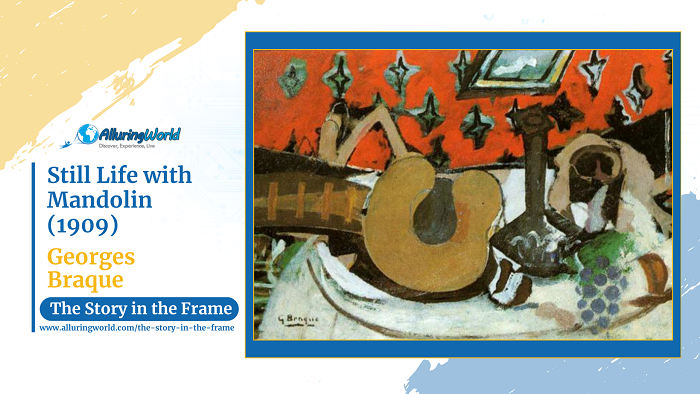Still Life with Mandolin, painted by Georges Braque in 1909–1910, is a key work from the early phase of Cubism which was a revolutionary art movement co-founded by Braque and Pablo Picasso. This painting exemplifies the analytical Cubist style, where objects are broken down into geometric forms and reassembled in a fragmented, abstracted manner, and by deconstructing traditional perspectives, Braque invites viewers to engage with the painting in a new way, challenging the conventions of depth, light, and form.
About the Painter:
Georges Braque (1882–1963) was a French painter and sculptor whose work played a crucial role in the development of modern art. Initially influenced by Fauvism, he later became a pioneer of Cubism alongside Picasso, and as Braque’s art focused on structure, perspective, and the interplay of form, moving away from traditional representation to explore new dimensions in visual perception, his influence extended beyond painting, shaping the trajectory of abstraction in the 20th century.
Inspiration and Reasons Behind the Painting:
Braque was deeply inspired by Paul Cézanne’s approach to form and perspective, which encouraged artists to view nature as a series of geometric shapes. Still Life with Mandolin reflects his exploration of multiple viewpoints within a single composition, a hallmark of analytical Cubism, and the choice of a mandolin, a familiar yet complex object, allowed Braque to experiment with fragmented forms and shifting planes, emphasizing structure over realistic depiction.
What is Depicted in the Painting:
The painting presents a mandolin, a tabletop, and other still-life elements, but rather than depicting them in a traditional manner, Braque dissects and reconfigures their shapes into overlapping planes. The mandolin itself is barely distinguishable at first glance, its curves and strings fragmented into angular forms, but shadows and contours dissolve into one another, forcing the viewer to actively piece together the composition, engaging with the artwork on an intellectual level.
Colors and Techniques:
Braque’s palette in the painting is dominated by muted, earthy tones, mainly by shades of brown, gray, and ochre, enhancing the analytical Cubist emphasis on form over color. Unlike Fauvism, which prioritized bold hues, Cubism reduced color to focus on the interplay of light and shadow within the fractured composition, and Braque’s use of shading techniques, such as subtle gradations of tone, creates an illusion of volume despite the flattened appearance of the objects. In addition to all this, the restrained color scheme also contributes to the painting’s structured, almost sculptural quality.
Conclusion:
Overall, Still Life with Mandolin is a significant example of Cubism’s radical departure from traditional representation since Braque’s deconstruction of form and space paved the way for modern abstraction, influencing countless artists and movements, and this painting remains an important milestone in art history, demonstrating how everyday objects can be transformed into complex explorations of perception and perspective.

